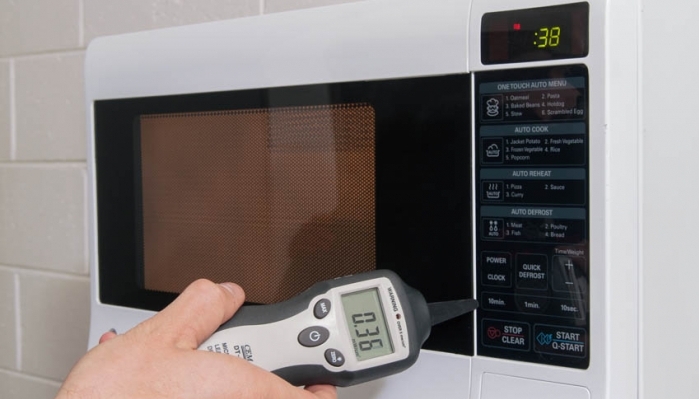Have you ever been worried about using a microwave oven, or wondered how to detect a microwave radiation leak?
Microwave ovens are extremely useful for people who live the fast life. The rate at which these ingenious appliances can cook food is astounding. When they’re used correctly, they can be your best friend, especially if you’re time poor.
They’re also very useful in the workplace. Obviously, you can’t stand in the kitchen at work and cook your meal from scratch, so the microwave comes in very handy indeed.
This poses the question; how do you know if the microwave oven you’re using is leaking radiation?
What are microwaves?
It might help by understanding what microwaves are. Microwaves are electromagnetic waves. Electromagnetic waves provide energy. Microwaves come in different lengths and are harnessed for many things including radio and TV broadcasting, mobile phones, and microwave ovens to name a few.
There are different types of microwaves, including;
- C-band: 4 to 8cm length, they penetrate through clouds, dust, smoke, snow and rain to reveal images of the earth’s surface. TV weather news stations use these to show radar images of the weather
- L-band: 15-30cm in length, used for mobile phones, long range surveillance, enroute traffic control, penetrating the canopy of forests to measure soil moisture levels in rainforests
- X-band: varying from 2.5 – 4cm in length, used by communication satellites to send signals to a ground station
How do these microwaves work?
How microwave ovens work
Microwaves harnessed for use in microwave ovens are a specific type of electromagnetic wave found in the S band. They penetrate food and force the molecules in the water and fat to rotate, or as some say, ‘get excited’.
As these molecules all rotate, they create heat. After a short period of time, the food is cooked. The reason there are rotating turntables in some microwave ovens is to ensure the microwaves penetrate the food more evenly.
It’s quite ingenious, but raises the question, if microwaves leak from the microwave oven, do they cause us harm?

Microwaves emit radiation
Like mobile phones and wi-fi, microwave ovens emit radiation. Without the right seals and construction, the kitchen would be bathed in radiation when microwave ovens are operating.
Research on microwave ovens and how to detect a microwave radiation leak has been carried out. It revealed that some microwave ovens shield radiation, while others don’t. The place the electromagnetic radiation escapes, as you probably expect, is through the door. The microwaves are believed to exploit the holes in the shielding of the door.
It’s inevitable that most microwaves will leak radiation. If you’re standing right next to the appliance as it cooks food, your body is being affected by a certain level of this electromagnetic radiation. For your peace of mind, it’s good to know that the government standards allow for a certain amount of radiation leakage from microwave ovens. This level is said to be completely harmless to the human body.
What does this all mean for you?
Testing your microwave oven is just as important as testing other electrical devices
It all boils down to testing your equipment and appliances to ensure they’re safe to operate. Microwave ovens are just one of many appliances used in a workplace and around the home.
You need a professional in the field of electrical testing to check the microwave oven leaks are within the safe levels set by federal standards. These standards were put in place to control the level of an individual’s exposure to radiation and ensure safety.
Technicians normally use a commercial grade EMF radiation leakage detector to identify any leakage coming from the microwave oven, and what level that leakage is. This way they can tell whether it’s within the guidelines set out by federal standards New Zealand, or at a level that is dangerous to humans.

What happens if your microwave oven fails the test?
Workplaces in New Zealand are required to develop safety plans to ensure that staff exposure to radiation is within the acceptable limits.
It may be that when tested, your microwave oven fails the test, and the leakage of microwave radiation is higher than the levels allowed by federal standards.
In the event of failing the microwave testing:
- A faulty sticker is normally placed on the appliance by the technician
- You’ll be informed the unit has failed the test
- You’ll be informed of the harmful effects that can result from using the faulty appliance
- You’ll be advised of how to dispose of it
- You’ll then be given a report detailing the specific failing
You can rely on Jim’s Test & Tag
For professional domestic and workplace inspection and testing, consumers choose Jim’s Test & Tag.
These highly trained technicians specialise in identifying visual and non-visual faults, and diagnosing those faults.
Using certified equipment to do the testing, Jim’s Test & Tag are precise and thorough, keeping accurate records as part of the process.
Your entire home and workplace can be inspected and tested, along with all appliances and equipment. With Jim’s Test & Tag, you’re protected on many levels, and you’ll know when the next appliance or equipment testing is due.
Regular testing and tagging are the only way to go for peace of mind.
You can rely on Jim’s Test & Tag.
Contact us now or fill in the online form for a free quote.







